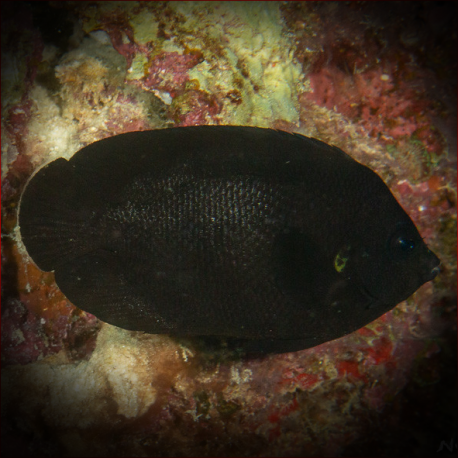More info
Datasheet
| Minimum Tank Size | 264 litres / 69.74 US gallons |
| Maximum Size | 10.2cm / 4.02inches |
| Reef Compatible | With Caution |
| Temperament | Semi-aggressive |
| Care Description | Moderate |
| Specific Gravity | 1.020-1.025 |
| Carbonate Hardness | 8-12 |
| pH | 8.1-8.4 |
General Description
The Black Nox Angelfish, scientifically known as Centropyge nox, is commonly referred to as the Midnight Angelfish due to its uniformly black coloration across its entire body. This species belongs to the Pomacanthidae family and can grow up to 10.2cm in size.
Aquarium Suitability
Requiring a minimum tank size of 70 gallons, the Black Nox Angelfish is best kept in a setup with ample hiding spots. It is advised to be the sole dwarf angelfish in the aquarium. This species is considered semi-aggressive and may not be suitable for reef environments as it has a tendency to consume soft coral polyps, clam mantles, and zoanthids.
Demands, Care, and Hardiness
With moderate care requirements, the Black Nox Angelfish thrives in water conditions with a pH of 8.1-8.4, a specific gravity of 1.020-1.025, and a carbonate hardness (KH) level between 8-12.
Reef Suitability
While the Black Nox Angelfish can be kept in a reef tank, it should be approached with caution due to its potential to feed on certain reef inhabitants.
Aquarium Setup
Creating a suitable environment for the Black Nox Angelfish involves providing ample hiding places within at least a 70-gallon tank. Maintaining stable water parameters within the specified range is crucial for the well-being of this species.
Behaviour
Known to be semi-aggressive, the Black Nox Angelfish may exhibit territorial behavior, especially towards other dwarf angelfish. It is essential to provide spaces for retreat to minimize aggression.
Feeding and Diet
As an omnivorous species, the diet of the Black Nox Angelfish should include a variety of foods such as Spirulina, marine algae, mysis shrimp, and other meaty fare. Live rock for grazing can also be beneficial for their overall nutrition.
Dimorphism and Captive Reproduction
There are no distinguishable differences in color between male and female Black Nox Angelfish. Breeding this species in an aquarium setting is very challenging and may require specialized care.
Habitat and Distribution
The Black Nox Angelfish is native to specific regions known for its black body coloration. This species can be found in certain habitats within its natural distribution range.

